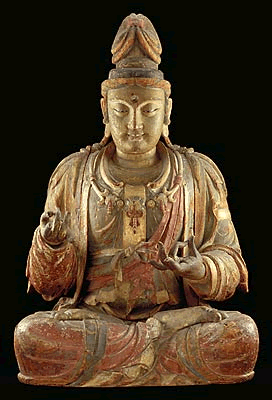The Cities of the Song
Temples & Religious Life
As in earlier cities, the highest structure in Kaifeng, the Northern Song’s capital, was a pagoda. Although pagodas do not appear in this scroll, they dominated the skyline of many cities during the Song dynasty, as they had in the Tang dynasty. Like the spires of Europe’s cathedrals and churches, the city pagoda was often the first thing the traveler would see as he approached a city or town. (The city we see in the Beijing qingming scroll is unusual in having only one relatively obscure temple.)
Buddhism flourished in the Tang and Song dynasties along with religious Daoism and a revival of Confucian thinking (referred to as “Neo-Confucianism”).
 |
|
The Bodhisattva Guanyin (Kuan-yin), Song (Sung) dynasty “[M]any historians agree that the last great moment in Chinese Buddhist sculpture occurred in the late Sung period, in the 12th and 13th centuries. Wooden sculpture at that time is perhaps the best we’ve ever seen.” Learn more about this sculpture at the Minneapolis Institute of Art website. |
|
More about the Kaifeng Pagoda
• Youguo Temple Iron Pagoda in Kaifeng of Henan Province [China Internet Information Center]
With a short description of the 11th-century “Iron Pagoda” in Kaifeng. Built in 1049, the pagoda is not actually made of iron, but its reddish glazed bricks and tiles give it that appearance.
• "Ancient China: The Iron Pagodo" by Ogibwa (Daily Kos) has excellent picture of the details on the exterior of the pagoda.